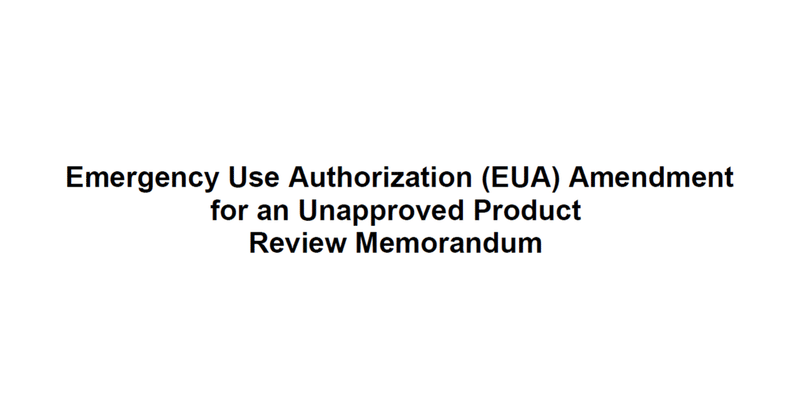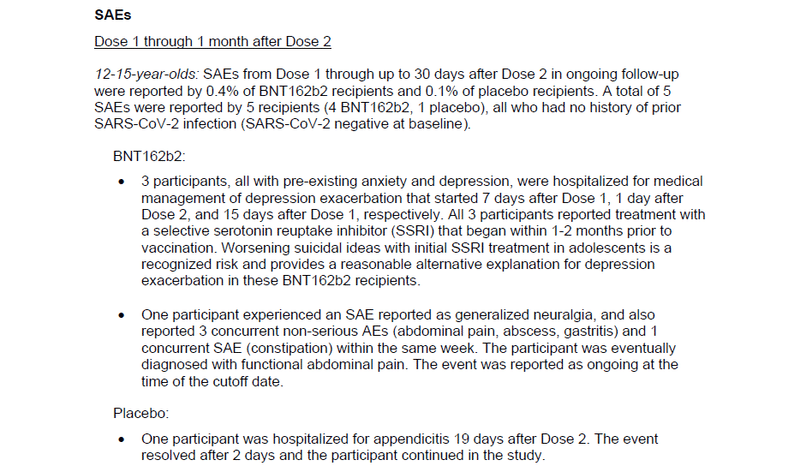
Pfizer-BioNTech COVID-19 Vaccine EUA Amendment Review Memorandum
この記事は前回の記事の補足です
資料をざっと追ってるだけなので、気になる部分の参考用にでも利用してください
前回の記事はこちら
この記事では前回の記事の根拠になった資料を紹介します
Pfizer-BioNTech COVID-19 Vaccine EUA Amendment Review Memorandum
前回の記事の根拠になったのが、以下の FDA(アメリカ食品医薬品局)の公開している Pfizer-BioNTech COVID-19 Vaccine EUA Amendment Review Memorandum という資料です
EUA というのは緊急使用許可のことで、アメリカでは新型コロナワクチンは正式承認されていないため、EUA に基づいて使用を許可されています
おそらくこの資料は EUA の年齢制限を16歳以上から12歳以上まで引き下げるにあたっての報告書のようなものだと思われます
用語
・(Unsolicited) AE - 有害事象
・SAE - 重篤な有害事象
・BNT162b2 - ファイザーの新型コロナワクチンのコードネーム
なお、発熱などワクチンと関連していることがわかっている、いわゆる副反応はこの資料では Solicited AE と表記されています
以下、資料の中からめぼしいところを取り上げていきます
Non-serious unsolicited AEs
非重篤な(SAE ではない)AE です

Differences in frequencies of AEs between the vaccine and placebo groups were notable for fever with onset within 7 days after vaccination and lymphadenopathy.
ワクチングループとプラセボグループで発生頻度に差があった AE は接種7日以内に発生した発熱とリンパ節腫脹が顕著でした。
5 (0.4%) BNT162b2 recipients and 0 placebo recipients reported fever.
5名(0.4%)のワクチン接種者と0名のプラセボ接種者が発熱を報告しました。
SAEs (Dose 1 through 1 month after Dose 2)
接種1回目から接種2回目の1カ月後までの間に発生した SAE です

BNT162b2:
• 3 participants, all with pre-existing anxiety and depression, were hospitalized for medical management of depression exacerbation that started 7 days after Dose 1, 1 day after Dose 2, and 15 days after Dose 1, respectively. All 3 participants reported treatment with a selective serotonin reuptake inhibitor (SSRI) that began within 1-2 months prior to vaccination. Worsening suicidal ideas with initial SSRI treatment in adolescents is a recognized risk and provides a reasonable alternative explanation for depression exacerbation in these BNT162b2 recipients.
3名の参加者はいずれも不安や抑うつの既往があり、それぞれ接種1回目の7日後、接種2回目の1日後、接種1回目の15日後に悪化した抑うつの治療のために入院した。3名ともワクチン接種の1~2カ月前に選択的セロトニン再取り込み阻害薬(SSRI)による治療を開始したことを報告している。青年が SSRI 治療の初期に自殺念慮が悪化することはリスクとして認められており、これらのワクチン接種者における抑うつの悪化の合理的な代替説明になる。
• One participant experienced an SAE reported as generalized neuralgia, and also reported 3 concurrent non-serious AEs (abdominal pain, abscess, gastritis) and 1 concurrent SAE (constipation) within the same week. The participant was eventually diagnosed with functional abdominal pain. The event was reported as ongoing at the time of the cutoff date.
1 名の参加者が全身性神経痛の SAE を報告し、同じ週に3件の非重篤の AE(腹痛、膿瘍、胃炎)と1件の SAE(便秘)の併発を報告した。この参加者は最終的に機能性腹痛と診断された。この事象はデータカットオフ日の時点で継続中と報告された。
Placebo:
• One participant was hospitalized for appendicitis 19 days after Dose 2. The event resolved after 2 days and the participant continued in the study.
1名の参加者が接種2回目の19日後に虫垂炎で入院した。この事象は2日後に解消され、参加者は治験を継続した。
SAEs (1 month after Dose 2 to data cutoff date or participant’s unblinding date)
接種2回目の1カ月後からデータカットオフ日、もしくは、盲検解除日(いずれか早い方)までに発生した SAE です

BNT162b2:
• 1 participant with constipation was diagnosed with functional abdominal pain after an extensive work-up; the participant also developed generalized neuralgia beginning 1 day after Dose 2 (described above).
1名の便秘の参加者は広範な精密検査の結果、機能性腹痛と診断された。この参加者は接種2回目の1日後から全身性神経痛を発症していた(前述のもの)。
• 1 participant with a long-standing history of ADHD and recent anxiety and depression diagnoses (4 months and 10 days prior to enrollment, respectively) was hospitalized for suicidal ideation 40 days after Dose 2. The event was ongoing at the time of the data cut-off date, but per the narrative provided by the Sponsor the event was assessed as resolved on March 15, 2021. The study investigator attributed the participant’s symptoms to psychosocial issues expressed by the participant as the cause of her exacerbation.
1名の参加者は長期にわたる ADHD の病歴があり、かつ最近、不安と抑うつの診断を受けていた(それぞれ登録の4カ月と10日前)が、接種2回目の40日後に自殺念慮のため入院した。この事象はデータカットオフ日の時点で継続していたが、治験実施者の談話によると、この事象は2021年3月15日に解消したと評価された。治験責任医師は、心理社会的な問題の兆候が悪化の原因であると参加者が述べたとしている。
Placebo:
• One participant was hospitalized for appendicitis 63 days after the Dose 2 of placebo. Symptoms were ongoing as of the data cutoff date.
1名の参加者はプラセボの接種2回目の63日後に虫垂炎で入院した。症状はデータカットオフ日の時点で継続中していた。
AEs leading to study withdrawal
治験中止に至った AE です

2 BNT162b2 recipients and no placebo recipients withdrew from the study due to an AE; one BNT162b2 recipient experienced fever (peak T40.3 ºC) [non-serious AE] starting 2 days after BNT162b2 Dose 1 and resolved after 2 days, and the other BNT162b2 recipient was hospitalized for exacerbation of pre-existing anxiety and depression (both SAEs; described above). The study investigator and FDA considered only the AE of fever to be related to vaccination.
2名のワクチン接種者と0名のプラセボ接種者が AE により治験を中止した。1名のワクチン接種者は接種1回目の2日後に発熱(ピークは40.3℃)(非重篤 AE)して2日後に解消し、もう1名のワクチン接種者は元からの不安と抑うつの悪化(共に SAE、前述のもの)のため入院した。治験責任医師と FDA は発熱の AE のみをワクチン接種と関連があるとみなした。
個人的な見解など
SSRI による一時的な症状の悪化はこちらのサイトに簡単な解説がありますが、悪化のタイミング、発生率の高さ、重篤さ、ベンゾジアゼピン系抗不安薬の併用で対処可能らしいことを考慮すると、抑うつの悪化を SSRI のせいにするのはちょっと厳しいようにも感じますがどうなんでしょう
以下のような論文もあるのでワクチンとの関連性も否定できないように思います
免疫と抑うつの関連性に関する論文
免疫と炎症性腸疾患の関連性に関する論文
この記事が気に入ったらサポートをしてみませんか?
